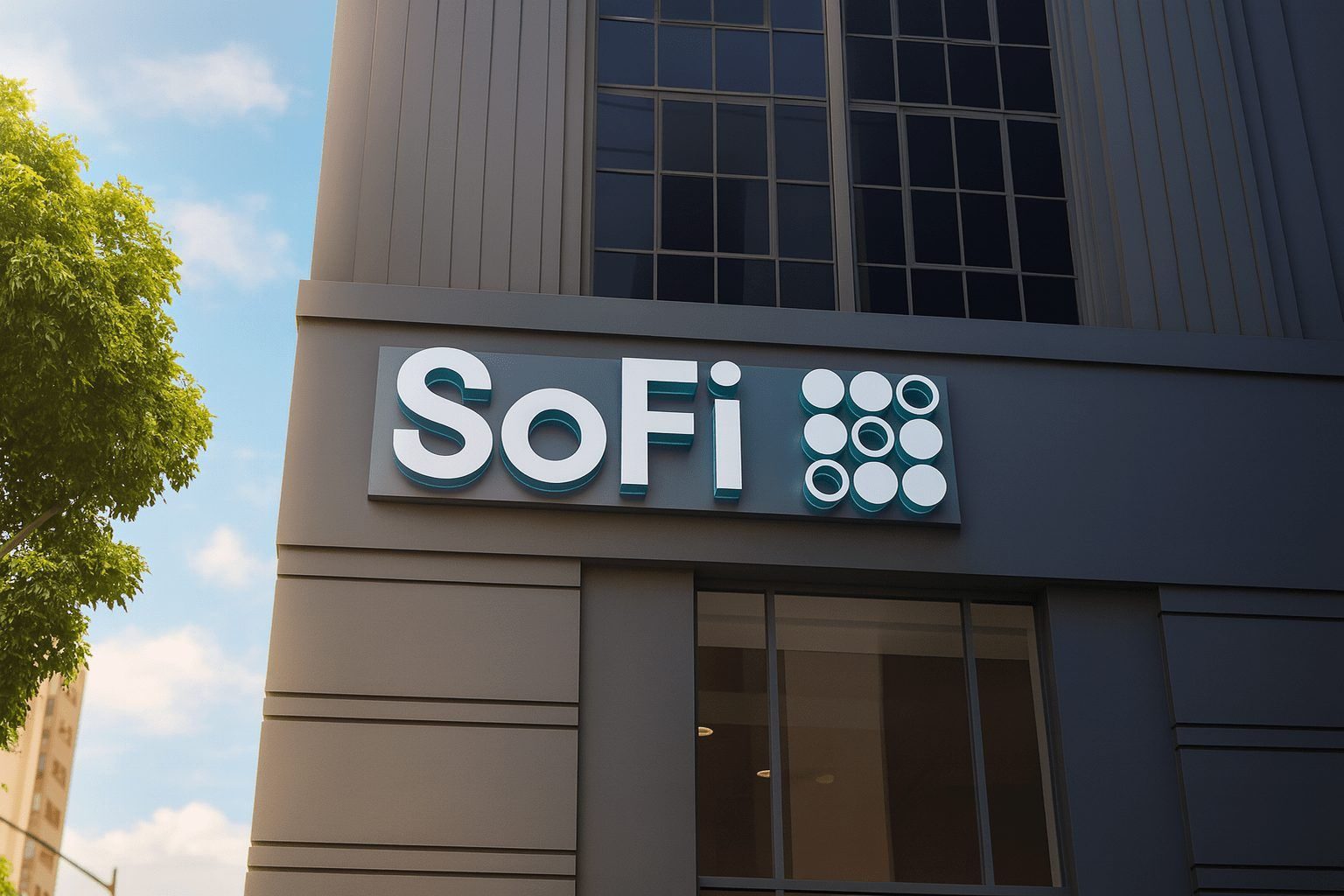Key takeaways
- SOFI stock is rebounding today. As of early afternoon on Monday, November 24, 2025, SoFi Technologies (NASDAQ: SOFI) is trading around $26.44, up roughly 5% on the day, after a volatile two weeks that saw the stock pull back from recent all‑time highs above $32. [1]
- Despite the pullback, 2025 has been a big up year. Data from FinanceCharts shows SoFi delivering about 64% year‑to‑date total return and nearly 68% over the past 12 months, far ahead of the S&P 500. [2]
- Fundamentals are strong: Q3 2025 brought record net revenue of $961.6 million (up 38% YoY), net income of $139 million, and diluted EPS of $0.11, marking the company’s eighth straight GAAP‑profitable quarter, with management raising full‑year 2025 guidance. [3]
- New growth lever: On November 11, SoFi relaunched SoFi Crypto, positioning itself as the first nationally chartered, FDIC‑insured U.S. bank to offer in‑app retail crypto trading, just as Bitcoin has been sliding sharply—adding a new source of revenue and a new source of risk. TS2 Tech+1
- Wall Street is bullish but cautious. Analysts broadly rate SOFI around “Hold”, with a median 12‑month price target near $27.50 and a wide range from $20 to $37, reflecting debate over whether the stock’s premium valuation (P/E ~47) leaves enough upside. [4]
SOFI stock today: bouncing after a rough stretch
SOFI came into Monday’s session under pressure, having dropped more than 10% over the past ten trading days amid a sharp Bitcoin sell‑off and broader volatility in high‑beta growth stocks. [5]
Today, the stock is trading around $26.44, up about $1.25 vs. Friday’s close of $25.19, a gain of nearly 5% on heavy volume. [6]
A few context points for where SOFI sits right now:
- Distance from the highs: SoFi’s all‑time closing high was $32.21 on November 12, 2025, and the 52‑week intraday high stands at $32.73. At roughly $26–27, shares are about 18% below that November peak. [7]
- Big move off the lows: Over the past year, SoFi has rallied from a 52‑week low of $8.60, reflecting the market’s reassessment of its path to profitability and growth. [8]
- Volatility remains high: Sites that track trading signals classify SOFI as a high‑risk / high‑volatility stock, with recent daily swings near 8% and a beta around 1.9–2.3 versus the broader market. [9]
In other words, today’s bounce is meaningful, but it’s happening inside a very choppy short‑term tape.
Earnings backdrop: record Q3 and raised 2025 guidance
Underneath the volatile share price, the fundamental story has been steadily improving.
In its Q3 2025 report, SoFi delivered: [10]
- GAAP net revenue: $961.6 million, up 38% year‑over‑year
- Adjusted net revenue: $949.6 million, up 38% YoY
- Net income: $139.4 million, more than double the prior‑year quarter
- Diluted EPS: $0.11 vs. $0.05 a year earlier
- Adjusted EBITDA: $276.9 million, up 49% YoY, with a 29% margin
- Eight consecutive quarters of GAAP profitability
The user metrics are just as important as the dollar figures:
- Members: SoFi added a record 905,000 new members in Q3, bringing total members to 12.6 million, up 35% YoY.
- Products: Total products grew to 18.6 million, up 36% YoY, with about 40% of new products opened by existing members—a sign that SoFi’s “one‑stop shop” strategy is working. [11]
On the revenue mix side, SoFi is increasingly less dependent on pure lending:
- Fee‑based revenue hit a record $408.7 million, up 50% YoY, driven by interchange fees, brokerage fees, loan platform fees, and other services.
- The Financial Services + Technology Platform segments together generated $534.2 million of net revenue, up 57% from a year ago, showing that the non‑lending engine is scaling. [12]
Management’s confidence showed up in guidance. Following the Q3 beat, SoFi raised its 2025 outlook to roughly: [13]
- Net revenue: about $3.54 billion
- Adjusted net income: about $455 million
At today’s share price, that guidance implies a forward P/E in the low 70s on 2025 EPS of ~$0.37, even though the trailing P/E is closer to 47x, highlighting just how much future growth the market is already baking in. [14]
Crypto relaunch: new fees, new scrutiny
The biggest new headline around SoFi this month is crypto.
On November 11, 2025, SoFi relaunched SoFi Crypto, allowing members to buy, sell and hold dozens of cryptocurrencies (including Bitcoin, Ethereum and Solana) directly inside the SoFi app, tightly integrated with SoFi Checking & Savings balances for instant funding. TS2 Tech+1
SoFi and several news outlets have emphasized that it is:
- The first and only nationally chartered, FDIC‑insured U.S. bank to offer this style of integrated crypto trading to retail investors. TS2 Tech+1
CEO Anthony Noto has framed the move as a long‑term strategic bet, calling blockchain and crypto a second “technology super‑cycle” alongside AI and arguing that SoFi is uniquely positioned to benefit from both. The company has also flagged plans for a USD stablecoin and deeper integration of blockchain rails into remittances, lending, and payments in 2026. [15]
However, the timing is tricky:
- Bitcoin has shed an estimated hundreds of billions of dollars in market value since its October peak, and SoFi’s own stock has dropped about 10–11% over the last 10 trading days as crypto markets rolled over. [16]
IBTimes notes that SoFi remains first and foremost a bank and lender, not a pure‑play crypto exchange, and argues that its core lending business and diversified revenue mix should leave the stock “relatively insulated” from Bitcoin’s wild swings—though investors clearly still react to crypto headlines. [17]
One important nuance for retail traders:
- SoFi deposits are FDIC‑insured, but crypto assets are not. SoFi’s own disclosures and FDIC guidance stress that digital assets held on such platforms do not carry FDIC insurance, even when accessed via a bank app. [18]
For shareholders, the crypto relaunch is a classic “higher reward, higher risk” catalyst: if adoption is strong, trading and spread fees could add a high‑margin revenue stream; if regulators tighten the screws or crypto remains weak, the payoff may be slower and the volatility higher.
How SoFi makes money now: three engines of growth
SoFi’s story is no longer just about refinancing student loans. The company now reports through three segments: Lending, Financial Services, and Technology Platform. [19]
1. Lending
This is still the biggest earnings driver, spanning personal loans, student loans, and home loans.
- Q3 total loan originations reached a record $9.9 billion, up 57% YoY.
- Personal loan originations hit $7.5 billion, student loans $1.5 billion, and home loans nearly $945 million, including a record $352 million of home‑equity loans. [20]
- Credit quality trends remain solid: net charge‑off rates fell over 20 basis points versus the prior quarter, and 90‑day delinquencies stayed essentially flat. [21]
This combination—high growth plus stable credit—has helped SoFi expand net interest income to $585.1 million in Q3, up 36% YoY, while benefiting from cheaper deposit funding relative to warehouse lines. [22]
2. Financial Services
This segment includes SoFi Money (checking & savings), SoFi Invest, credit cards, and other consumer products.
- Q3 Financial Services net revenue climbed to $419.6 million, up 76% YoY, with non‑interest income (fees and interchange) more than doubling. [23]
- Management highlights strong engagement, with members increasingly using multiple products and features such as AI‑powered “Cash Coach”, Level 1 options trading, and expanded access to alternative investments. [24]
This is the segment most likely to benefit from SoFi Crypto, as trading, custody and potential stablecoin revenues layer into what is already a high‑margin fee business.
3. Technology Platform (Galileo + Technisys)
The Technology Platform segment powers embedded finance and banking‑as‑a‑service for other brands—think powering debit cards, wallets, and rewards programs behind the scenes.
- Q3 tech‑platform net revenue was about $115 million, up roughly 12% YoY, even as total enabled accounts dipped slightly, indicating the focus is on higher‑value relationships rather than just raw account numbers. TS2 Tech+1
- Recent partnerships include powering debit‑rewards programs for major consumer brands, and industry research highlights embedded finance as a fast‑growing global theme, including in regions like the Middle East. TS2 Tech+1
For shareholders, the technology segment matters because it generates recurring, fee‑based revenue, helping reduce SoFi’s sensitivity to interest rates and credit cycles.
What Wall Street and big money are doing with SOFI
Analyst ratings and price targets
Across Wall Street, sentiment on SOFI is mixed but engaged:
- Quiver Quantitative and MarketBeat data show a consensus “Hold” rating, with multiple buys and several underperform / sell ratings still in place. [25]
- Over the last few months, major firms including Citigroup, Needham, Truist, UBS, Goldman Sachs and JPMorgan have updated coverage, with targets ranging from $20 (bearish) to $37 (bullish) and a median around $27.50—very close to where the stock trades today. [26]
In other words, the Street generally agrees SoFi is a real, scaled business with strong growth, but disagrees on how much of that future is already in the price.
Hedge funds, institutions and insiders
Institutional and hedge‑fund interest in SoFi is substantial:
- Quiver’s institutional holdings data show 536 investors increasing positions and 363 trimming in the latest quarter, with JPMorgan, BlackRock, Susquehanna, Jane Street and Vanguard all adding millions of shares. [27]
- MarketBeat highlights that TD Waterhouse Canada boosted its stake in Q2 by over 400%, and notes that roughly 38% of the float is held by institutions and hedge funds. [28]
At the same time, insiders have mostly been selling, not buying:
- Quiver tallies 11 insider sales and zero open‑market purchases in the last six months, including sales by the CTO, Chief Risk Officer and other senior executives, totaling hundreds of thousands of shares. [29]
Insider selling isn’t automatically a red flag—executives often sell for diversification or tax reasons—but the lack of insider buying is one of the points cautious investors cite.
Valuation check: premium price tag for a high‑growth bank‑fintech hybrid
Today’s rally puts SoFi at a market capitalization of around $30–31 billion, and valuation metrics are tough to ignore: [30]
- Trailing P/E: ~46–47x
- PEG ratio (price/earnings to growth): roughly 2.5x
- Beta: ~1.9, highlighting high volatility
- YTD total return: about 63–64%, top‑quartile within its financial‑services peer group. [31]
A Seeking Alpha analyst piece published this morning summed it up by calling SoFi an “exceptional business with a premium price tag”, praising the growth, underwriting, and fee diversification while warning that elevated multiples leave less room for disappointment. [32]
Simply Wall St, meanwhile, flags that the market may be over‑estimating SoFi’s rapid growth given competitive and macroeconomic headwinds, even while acknowledging its strong position among digital payment and embedded‑finance names. [33]
For investors, the core valuation question is simple:
Is SoFi still a turnaround/growth story being re‑rated higher, or has it already priced in most of that transformation?
Key catalysts and risks to watch next
Potential upside drivers
- Execution on guidance and further beats
If SoFi continues to beat on revenue and EPS while maintaining credit quality, the Street may lift estimates and price targets, supporting the current valuation or even pushing it higher. [34] - Scaling of SoFi Crypto and blockchain initiatives
Strong uptake of crypto trading, remittances and a future SoFi‑branded stablecoin could add high‑margin fee income and deepen member engagement, especially among younger, tech‑savvy customers. TS2 Tech+1 - Interest‑rate environment
If the Federal Reserve moves toward rate cuts in 2026, cheaper funding and renewed appetite for refinancing could benefit SoFi’s lending economics, particularly given its deposit‑based funding advantage over warehouse lines. (This is an inference based on how banks and lenders typically behave in easing cycles.) - Technology Platform wins
New Galielo/Technisys deals with large consumer brands can add sticky, fee‑based revenue at scale, reinforcing the “fintech infrastructure” side of the story. TS2 Tech+1
Main risks
- Macro and credit cycle
A weaker economy—higher unemployment, rising delinquencies—could force SoFi to tighten lending, build reserves, or accept slower growth, pressuring margins and EPS. - Regulatory scrutiny on bank‑crypto hybrids
U.S. regulators have issued guidance for banks handling crypto assets, and a more conservative stance could limit how aggressively SoFi can expand its crypto and stablecoin plans. [35] - Valuation and sentiment risk
With SOFI trading at a premium to many traditional banks and even some mature fintechs, any negative surprise—earnings miss, credit deterioration, regulatory setback—could trigger a sharp rerating. - Execution complexity
Running a fast‑growing consumer bank, a trading app, and an embedded‑finance platform simultaneously is operationally complex. Missteps in technology, risk management, or compliance could erode the brand and invite regulatory action.
Is SOFI stock a buy, sell or hold today?
Whether SOFI is attractive today, at around $26–27, depends heavily on your risk tolerance and time horizon:
- The bull thesis:
Supporters see SoFi as a rare combination of high‑growth digital bank + fintech infrastructure + consumer super‑app, already profitable and compounding revenue at ~30–40% a year, with big optionality in AI, crypto and embedded finance. From that perspective, a premium multiple is justified, and any pullbacks from the $30+ highs are opportunities to accumulate for the long term. [36] - The bear (or cautious) thesis:
Skeptics focus on the lofty valuation, insider selling, high volatility, and new crypto‑related headline risk, arguing that a lot of good news is already reflected in the price. For them, SOFI looks more like a “show‑me” story that could be vulnerable if growth slows or the credit cycle turns. [37]
For many investors, that translates to a practical takeaway:
- If you already own SOFI, today’s bounce might be a reminder to revisit your thesis, position size, and time horizon rather than trading on short‑term volatility alone.
- If you’re considering a new position, it’s worth modeling scenarios using SoFi’s own guidance, analyst forecasts, and your assumptions about credit and regulation to decide whether paying a premium multiple fits your portfolio strategy.
Disclaimer: This article is for informational and educational purposes only and is not financial, investment, tax, or legal advice. Stock investing involves risk, including the possible loss of principal. Always do your own research and consider consulting a licensed financial adviser before making investment decisions.
References
1. www.investing.com, 2. www.financecharts.com, 3. investors.sofi.com, 4. www.marketbeat.com, 5. www.ibtimes.co.uk, 6. stockinvest.us, 7. www.investing.com, 8. stockinvest.us, 9. www.marketbeat.com, 10. investors.sofi.com, 11. investors.sofi.com, 12. investors.sofi.com, 13. 247wallst.com, 14. www.marketbeat.com, 15. investors.sofi.com, 16. www.ibtimes.co.uk, 17. www.ibtimes.co.uk, 18. www.ibtimes.co.uk, 19. seekingalpha.com, 20. investors.sofi.com, 21. investors.sofi.com, 22. investors.sofi.com, 23. investors.sofi.com, 24. investors.sofi.com, 25. www.quiverquant.com, 26. www.quiverquant.com, 27. www.quiverquant.com, 28. www.marketbeat.com, 29. www.quiverquant.com, 30. www.marketbeat.com, 31. www.financecharts.com, 32. seekingalpha.com, 33. simplywall.st, 34. investors.sofi.com, 35. www.ibtimes.co.uk, 36. investors.sofi.com, 37. www.quiverquant.com







